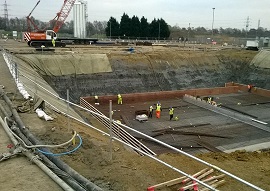Ground
The term ‘ground’ typically refers to the solid surface of the Earth or an area that is used for a specified purpose.
It can also be used to refer to the storey of a building that is on the ground, i.e. ‘ground level’ or ‘ground floor’.
In terms of the physical matter of the ground, it is made up of different layers. Topsoil is the first, upper layer of soil, typically measuring between 5 - 20 cm (2 - 8 inches) deep. It can also be measured as the depth from the surface level to the subsoil, i.e. the distance to the first densely-packed layer of soil. Subsoil is the layer (or stratum) of soil immediately underneath the surface topsoil. Beneath the subsoil is the substratum - a layer of residual bedrock, sediments or deposits.
The ‘water table’ is the below-ground level that marks the transition between ground that is saturated with water and ground that is not saturated. The upper, unsaturated level, is known as the 'capillary fringe' or 'zone of aeration'.
In terms of construction, ‘groundworks’ refers to work done to prepare sub-surfaces for the start of construction work. Aside from any demolition or site enabling works that may need to be carried out, groundworks are usually the first stage of a construction project.
Ground investigations are a means of determining the condition of the ground, ideally before beginning construction works. They focus specifically on intrusive geotechnical work such as trial pits and boreholes. An assessment of ground conditions typically includes geology, hydrology, hydrogeology and soil conditions of a site and surrounding, along with any contaminated land.
There are a number of ground improvement or ground modification techniques that can be used to stabilise or improve the condition of an area of ground before construction work takes place. This may be necessary to improve or modify the ground shear strength, stiffness, permeability, and so on.
Designing Buildings Wiki has a number of articles relating to the ground, including:
- Alluvium.
- Bearing capacity.
- Building foundations.
- Clay.
- Contaminated land.
- Ecological survey.
- Excavation.
- Geophysical survey.
- Ground anchor.
- Ground conditions.
- Ground energy options.
- Ground heave.
- Ground improvement techniques.
- Ground level.
- Ground-penetrating radar.
- Ground source heat pumps.
- Ground storey.
- Groundworks.
- In situ testing of soils.
- Land surveying.
- Methane and other gasses from the ground.
- Minerals surveyor.
- Road construction.
- Settlement.
- Sinkholes.
- Soil report.
- Soil survey.
- Subsidence.
- Subsoil.
- The importance of soil analysis.
- Topsoil.
- Types of soil.
- Underpinning.
- Underreaming.
- Vibro-compaction.
- Water table.
[edit] Related articles on Designing Buildings Wiki
Featured articles and news
Infrastructure that connect the physical and digital domains.
Harnessing robotics and AI in challenging environments
The key to nuclear decommissioning and fusion engineering.
BSRIA announces Lisa Ashworth as new CEO
Tasked with furthering BSRIA’s impressive growth ambitions.
Public buildings get half a million energy efficiency boost
£557 million to switch to cleaner heating and save on energy.
CIOB launches pre-election manifesto
Outlining potential future policies for the next government.
Grenfell Tower Inquiry announcement
Phase 2 hearings come to a close and the final report due in September.
Progress from Parts L, F and O: A whitepaper, one year on.
A replicated study to understand the opinion of practitioners.
ECA announces new president 2024
Electrical engineer and business leader Stuart Smith.
A distinct type of countryside that should be celebrated.
Should Part O be extended to existing buildings?
EAC brands heatwave adaptation a missed opportunity.
Definition of Statutory in workplace and facilities management
Established by IWFM, BESA, CIBSE and BSRIA.
Tackling the transition from traditional heating systems
59% lack the necessary information and confidence to switch.
The general election and the construction industry
As PM, Rishi Sunak announces July 4 date for an election.
Eco apprenticeships continue help grow green workforce
A year after being recognised at the King's coronation.
Permitted development rights for agricultural buildings
The changes coming into effect as of May 21, 2024.






















